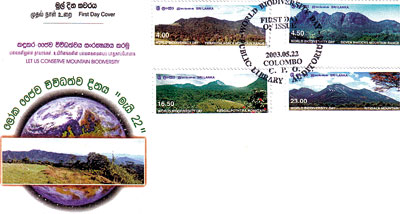Based on the elevation and nature of the terrain, four main geomorphic regions have been identified in Sri Lanka. They are:
1 The Central highlands
2 Coastal fringe
3 South-West country
4 East & South-East
country &
5 North Central lowland
The mountainous
environment of Sri Lanka is best seen in the Central highlands where the
highest mountains are located. Mountains are
an important source of water, energy and
biological diversity.
Other valuable resources like such as minerals,
forests and agricultural products also originate from these.
As a major sub-system
of the complex and
inter-related ecology of our planet, mountainous
environments are
essential for the survival of the national and global
eco-systems.
Four stamps released on World Biodiversity day 2003 (May 22), feature the best known mountainous environments of Sri Lanka.
Pidurutalagala
mountain range is depicted in the Rs. 4 stamp. The highest in Sri Lanka, Pidurutalaga mountain is 2,524 metres high and is located near Nuwara Eliya town. It is the home of a
forest with high mountain
features and is always enveloped in mist. Because of the high wind and mist, the flora in the region is unique. Even in the
summit of the mountain, the stunted and twisted flora leaning against the wind can be seen.
As many as 112 plant species belonging to
41 plant families have been identified. Out of these while 57 are endemic to
Sri Lanka another
16 rare varieties are
threatened with extinction. Commonly seen varieties include Calophyllum
(nelu), Rhododendran
(maharathmal) and Litsea gardenri (talan). Fauna in the Pidurutalaga region include 30 amphibian,
five bird, six butterfly,
10 mammalian, three
reptilian and five mollusc species.
Among several
species endemic to Sri Lanka is the Cerataphora stoddartii (ang katussa). Seven amphibian, three bird and five mammalian species are facing the
danger of extinction.
Seven Maidens
mountain range (Rs. 4.50 stamp) is located near Laksapana waterfall in the Nuwara Eliya district. Ballapennagala is the
highest mountain in the region recording a height of 1,276 metres. The plane crash that occurred in the 1970s killing a pilgrim party on their way to Mecca brought the range to global
attention.
A good part of the range which is covered with
forest is rocky. Plant diversity seen in Sri Pada (Adam's Peak) region in the south-west of the range is common to the entire region.
Sixty five plant families including 155 kinds and 256 species have been
identified. Six are rare
and 148 are endemic to
Sri Lanka. The fauna
comprises 72 species which include 39 endemic ones comprising eight
mammalian, 12 reptilian, 30 bird and nine amphibian varieties.
Kirigalpotta mountain (Rs. 16.50) is the second highest in Sri Lanka at a height of 2,395 metres and is located near Horton Plains in the southern part of Nuwara Eliya district. The plant community here also has high mountain forest features due to high winds, rainy weather and continuous mist. Pigmy trees with twisted branches are most common.
The lower region of the
forest is covered with
strobilanthes and
szyglum and a flat area with pigmy trees is visible at the top. Mammalian
species lioke the leopard and samba, reptile
species like the lizard (Cerataphora
stoddartii) and endemic bird species like the Sri Lanka dull-blue fly catcher and the
Sri lanka yellow-eared bulbul are to be found in the region.
In addition to being a unique biodiversity area, Kirigalpotta is also a
catchment area for the Belihul Oya.
Ritigala mountain
(Rs. 21) is the highest peak in the North Central Province at a height of 764.5 metres and is located in the district of Anuradhapura.
Steeped
in history, Ritigala is
mentioned in the Mahavamsa, the Great Chronicle, thus recording the longest history for a peak apart from Sri Pada.
History records Ritigala as a military outpost and during the reign of King Suratissa (187 – 177 BC) became a religious place. Thereafter several kings had built temples and
dagobas which were destroyed due to foreign invasions.
In 1887, an Englishman, Henry Trieman climbed Ritigala and studied the fauna and flora and found its biological importance.
Though in the dry zone, Ritigala contains
different kinds of plants which belong to different zones in the country.
Over 400 varieties plant
species have been
identified with several endemic to Sri Lanka. Among them 'Ritigala mee' (Madhuca clavata) is
special to Ritigala.
Mammals like the
elephant, leopard and bear can be seen at Ritigala.
Well known as a herbal garden, Ritigala boasts of 'rare varieties like 'bing kohomba', 'vanaraja', 'kuda hadaya' and 'maha hedaya'.
Ritigala was declared a Strict Natural Reserve in 1941 in recognition of its uniqueness in biodiversity.
|


